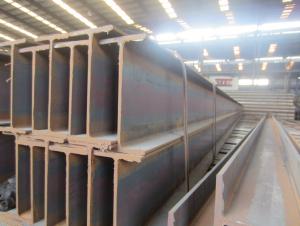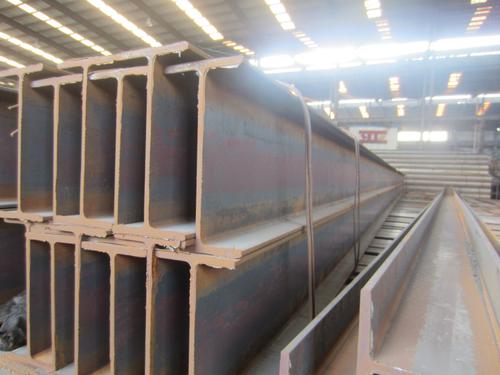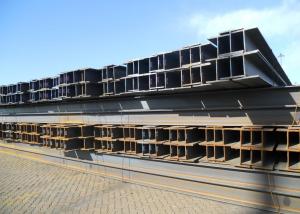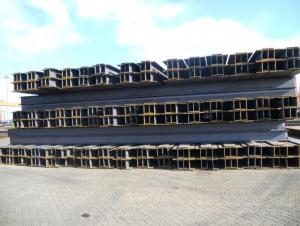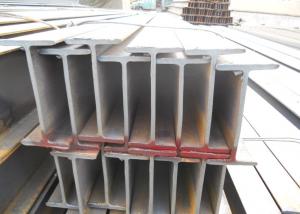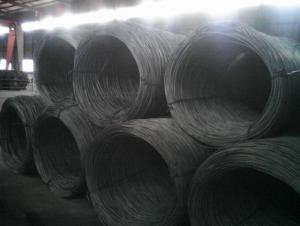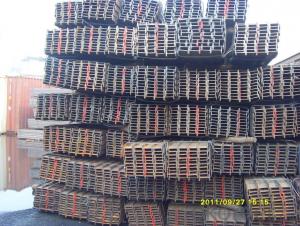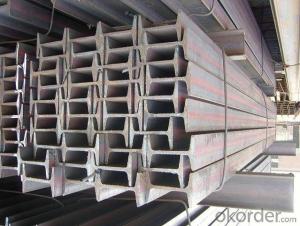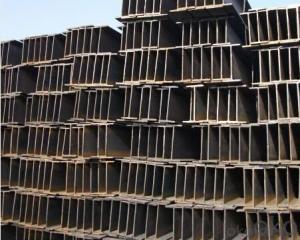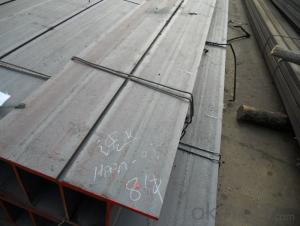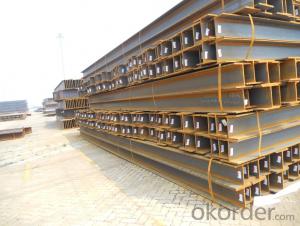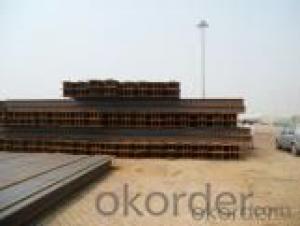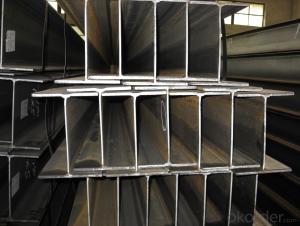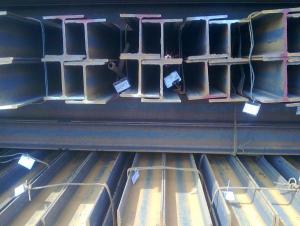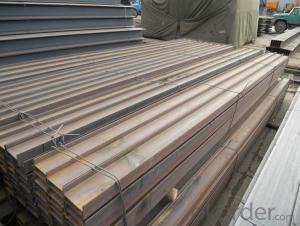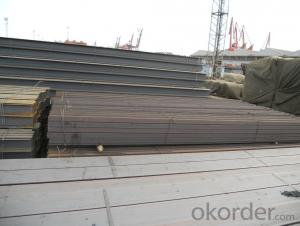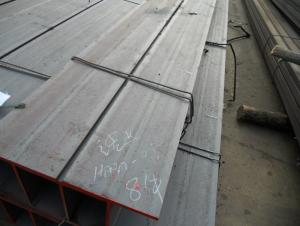Prime Hot Rolled H Beam Steel
- Loading Port:
- China Main Port
- Payment Terms:
- TT or LC
- Min Order Qty:
- 100 m.t.
- Supply Capability:
- -
OKorder Service Pledge
OKorder Financial Service
You Might Also Like
Product Description:
OKorder is offering Prime Hot Rolled H Beam Steel at great prices with worldwide shipping. Our supplier is a world-class manufacturer of steel, with our products utilized the world over. OKorder annually supplies products to African, South American and Asian markets. We provide quotations within 24 hours of receiving an inquiry and guarantee competitive prices.
Product Applications:
Prime Hot Rolled H Beam Steel are ideal for structural applications and are widely used in the construction of buildings and bridges, and the manufacturing, petrochemical, and transportation industries.
Product Advantages:
OKorder's Prime Hot Rolled H Beam Steel are durable, strong, and wide variety of sizes.
Main Product Features:
· Premium quality
· Prompt delivery & seaworthy packing (30 days after receiving deposit)
· Can be recycled and reused
· Mill test certification
· Professional Service
· Competitive pricing
Product Specifications:
Manufacture: Hot rolled
Grade: Q195 – 235
Certificates: ISO, SGS, BV, CIQ
Length: 12m, as per customer request
Packaging: Export packing, nude packing, bundled
| H BEAM | ||||||
| size | h (MM) | b (MM) | t1 (MM) | t2 (MM) | Mass: Kg/m | LENGTH |
| 100x100 | 100 | 100 | 6.0 | 8 | 16.9 | 12M |
| 125x125 | 125 | 125 | 6.5 | 9 | 23.6 | 12M |
| 150x75 | 150 | 75 | 5.0 | 7 | 14.0 | 12M |
| 148x100 | 148 | 100 | 6.0 | 9 | 20.7 | 12M |
| 150x150 | 150 | 150 | 7.0 | 10 | 31.1 | 12M |
| 175x90 | 175 | 90 | 5.0 | 8 | 18.0 | 12M |
| 175x175 | 175 | 175 | 5.0 | 11 | 40.4 | 12M |
| 198x99 | 198 | 99 | 4.5 | 7 | 17.8 | 12M |
| 200x100 | 200 | 100 | 5.5 | 8 | 20.9 | 12M |
| 194x150 | 194 | 150 | 6.0 | 9 | 29.9 | 12M |
| 200x200 | 200 | 200 | 8.0 | 12 | 49.9 | 12M |
| 200x204 | 200 | 204 | 12.0 | 12 | 56.2 | 12M |
| 248x124 | 248 | 124 | 5.0 | 8 | 25.1 | 12M |
| 250x125 | 250 | 125 | 6.0 | 9 | 29.0 | 12M |
| 244x175 | 244 | 175 | 7.0 | 11 | 43.6 | 12M |
| 250x250 | 250 | 250 | 9.0 | 14 | 71.8 | 12M |
| 250x255 | 250 | 255 | 14.0 | 14 | 81.6 | 12M |
| 298x149 | 298 | 149 | 5.5 | 8 | 32.0 | 12M |
| 300x150 | 300 | 150 | 6.5 | 9 | 36.7 | 12M |
| 294x200 | 294 | 200 | 8.0 | 12 | 55.8 | 12M |
| 294x302 | 294 | 302 | 12.0 | 12 | 83.4 | 12M |
| 300x300 | 300 | 300 | 10.0 | 15 | 93.0 | 12M |
| 300x305 | 300 | 305 | 15.0 | 15 | 105.0 | 12M |
| 346x174 | 346 | 174 | 6.0 | 9 | 41.2 | 12M |
| 350x175 | 350 | 175 | 7.0 | 11 | 49.4 | 12M |
| 340x250 | 340 | 250 | 9.0 | 14 | 78.1 | 12M |
| 344x348 | 344 | 348 | 10.0 | 16 | 113.0 | 12M |
| 350x350 | 350 | 350 | 12.0 | 19 | 135.0 | 12M |
| 396x199 | 396 | 199 | 7.0 | 11 | 56.1 | 12M |
| 400x200 | 400 | 200 | 8.0 | 13 | 65.4 | 12M |
| 400x300 | 400 | 300 | 10.0 | 16 | 105 | 12M |
| 388x402 | 388 | 402 | 15.0 | 15 | 140 | 12M |
| 394x398 | 394 | 398 | 11.0 | 18 | 147 | 12M |
| 400x400 | 400 | 400 | 13.0 | 21 | 172 | 12M |
| 400x408 | 400 | 408 | 21.0 | 21 | 197 | 12M |
| 414x405 | 414 | 405 | 18 | 28 | 232 | 12M |
| 428x407 | 428 | 407 | 20 | 35 | 283 | 12M |
| 458x417 | 458 | 417 | 30 | 50 | 415 | 12M |
| 498x432 | 498 | 432 | 45 | 70 | 605 | 12M |
| 446x199 | 446 | 199 | 8 | 12 | 65.1 | 12M |
| 450x200 | 450 | 200 | 9 | 14 | 74.9 | 12M |
| 440x300 | 440 | 300 | 11 | 18 | 121 | 12M |
| 496x199 | 496 | 199 | 9 | 14 | 77.9 | 12M |
| 500x200 | 500 | 200 | 10 | 16 | 88.2 | 12M |
| 506x201 | 506 | 201 | 11 | 19 | 102 | 12M |
| 482x300 | 482 | 300 | 11 | 15 | 111 | 12M |
| 488x300 | 488 | 300 | 11 | 18 | 125 | 12M |
| 596x199 | 596 | 199 | 10 | 15 | 92.5 | 12M |
| 600x200 | 600 | 200 | 11 | 17 | 103 | 12M |
| 606x201 | 606 | 201 | 12 | 20 | 118 | 12M |
| 582x300 | 582 | 300 | 12 | 17 | 133 | 12M |
| 588x300 | 588 | 300 | 12 | 20 | 147 | 12M |
| 594x302 | 594 | 302 | 14 | 23 | 170 | 12M |
| 692x300 | 692 | 300 | 13 | 20 | 163 | 12M |
| 700x300 | 700 | 300 | 13 | 24 | 182 | 12M |
| 792x300 | 792 | 300 | 14 | 22 | 188 | 12M |
| 800x300 | 800 | 300 | 14 | 26 | 207 | 12M |
| 890x299 | 890 | 299 | 15 | 23 | 210 | 12M |
| 900x300 | 900 | 300 | 16 | 28 | 240 | 12M |
| 912x302 | 912 | 302 | 18 | 34 | 283 | 12M |
FAQ:
Q1: Why buy Materials & Equipment from OKorder.com?
A1: All products offered byOKorder.com are carefully selected from China's most reliable manufacturing enterprises. Through its ISO certifications, OKorder.com adheres to the highest standards and a commitment to supply chain safety and customer satisfaction.
Q2: How do we guarantee the quality of our products?
A2: We have established an advanced quality management system which conducts strict quality tests at every step, from raw materials to the final product. At the same time, we provide extensive follow-up service assurances as required.
Q3: How soon can we receive the product after purchase?
A3: Within three days of placing an order, we will arrange production. The normal sizes with the normal grade can be produced within one month. The specific shipping date is dependent upon international and government factors, the delivery to international main port about 45-60days.
Images:
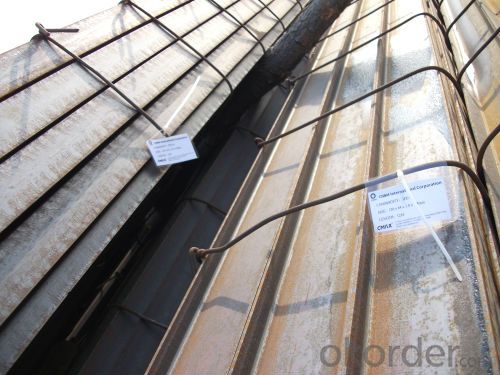
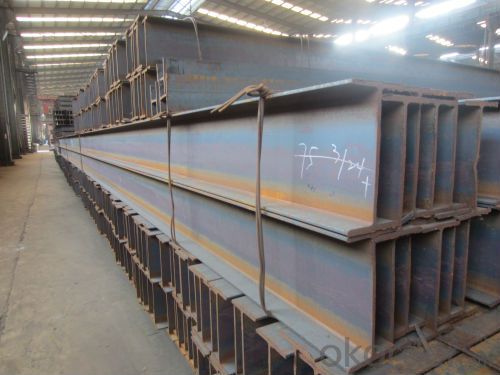
- Q: Can steel H-beams be used for supporting conveyor systems?
- Yes, steel H-beams can be used for supporting conveyor systems. Steel H-beams are commonly used in construction and industrial applications due to their strength and durability. They provide excellent support for heavy loads and are capable of withstanding the weight and vibrations associated with conveyor systems. Additionally, their shape allows for easy attachment of other components and accessories required for conveyor installation. However, it is important to ensure that the specific steel H-beam selected meets the required load-bearing capacity and is properly engineered and installed to ensure the safety and stability of the conveyor system.
- Q: Can Steel H-Beams be used in data center or IT facility construction?
- Yes, Steel H-Beams can be used in data center or IT facility construction. Steel H-Beams are commonly used in commercial construction projects due to their structural strength and versatility. They provide excellent load-bearing capabilities, making them suitable for supporting heavy equipment and infrastructure in data centers and IT facilities. Additionally, Steel H-Beams are durable, fire-resistant, and can withstand extreme weather conditions, ensuring the safety and longevity of the facility. Their flexibility allows for easy customization and expansion, which is essential in dynamic environments like data centers. Overall, Steel H-Beams are a reliable and efficient choice for constructing data centers or IT facilities.
- Q: Can Steel H-Beams be used in elevated or suspended structures?
- Yes, Steel H-Beams can be used in elevated or suspended structures. Steel H-Beams are commonly used in construction due to their strength, stability, and durability. They are designed to carry heavy loads and provide structural support, making them suitable for various applications, including elevated or suspended structures. These beams can be used in the construction of bridges, mezzanines, platforms, walkways, and other similar structures where elevated or suspended support is required. The H-shape of the beam provides excellent load-bearing capacity and allows for even distribution of weight, ensuring the stability and safety of the structure. Additionally, Steel H-Beams can be customized to meet specific design requirements and can be easily interconnected or joined with other structural members to create a robust and reliable framework. Therefore, Steel H-Beams are an ideal choice for elevated or suspended structures that demand high strength and stability.
- Q: What are the considerations when designing for vibration control in Steel H-Beams?
- When designing for vibration control in Steel H-Beams, there are several important considerations to keep in mind. First and foremost, it is crucial to understand the anticipated dynamic loads and frequencies that the H-Beams will be subjected to. This knowledge will help determine the appropriate design parameters and materials required to effectively dampen vibrations. Another consideration is the selection of the appropriate damping techniques. This can include the use of various damping materials or devices, such as viscoelastic materials or tuned mass dampers, to absorb or dissipate the energy generated by vibrations. Additionally, the structural integrity of the H-Beams must be carefully evaluated to ensure that they can withstand the dynamic loads without experiencing excessive deformation or failure. This involves analyzing the beam's natural frequencies, modal shapes, and critical damping ratios to ensure proper functionality and safety. Finally, it is important to consider the overall structural system and its interaction with the H-Beams. Factors such as the support conditions, connections, and adjacent components can affect the overall vibration response. Therefore, a comprehensive analysis of the entire system should be conducted to ensure effective vibration control in Steel H-Beams.
- Q: What are the different joining techniques used for connecting steel H-beams?
- There are several different joining techniques that can be used to connect steel H-beams. These techniques are used to ensure that the beams are securely connected and can withstand the loads and forces that they will be subjected to. Some of the common joining techniques for steel H-beams include: 1. Welding: This is one of the most common and widely used methods for joining steel H-beams. Welding involves melting the edges of the beams and fusing them together using heat. It provides a strong and permanent connection, but it requires skilled labor and proper welding techniques to ensure the quality and integrity of the joint. 2. Bolting: Another commonly used method for joining steel H-beams is through bolting. This involves using bolts, nuts, and washers to connect the beams together. Bolting provides a strong and durable connection, and it allows for easy disassembly and reassembly if needed. It is also less time-consuming compared to welding. 3. Riveting: Riveting is an older technique that involves using metal pins or rivets to connect the steel H-beams. This method requires drilling holes in the beams and inserting the rivets, which are then hammered or compressed to secure the joint. Riveting provides a strong connection, but it is less commonly used nowadays due to the availability of more efficient joining techniques. 4. Adhesive bonding: Adhesive bonding involves using high-strength adhesives or epoxy resins to bond the steel H-beams together. This method provides a lightweight and flexible connection, but it may not be suitable for applications that require high load-bearing capacity or where temperature variations are significant. 5. Mechanical connectors: Mechanical connectors, such as beam clamps or angle brackets, can also be used to join steel H-beams. These connectors are designed to provide a quick and easy connection, often without the need for welding or drilling. They are commonly used in construction projects where time and efficiency are crucial. It is important to note that the choice of joining technique depends on several factors, including the structural requirements, load-bearing capacity, project specifications, and budget. Consulting with a structural engineer or a qualified professional is recommended to determine the most suitable joining technique for connecting steel H-beams in a specific application.
- Q: Can steel H-beams be used in hospital buildings?
- Indeed, hospital buildings can incorporate steel H-beams. The prevalence of steel H-beams in construction arises from their robustness, resilience, and capacity to bear substantial loads. This renders them apt for hospital structures, where utmost consideration is given to the safety and stability of the edifice. Moreover, steel H-beams exhibit resistance against fire, corrosion, and pests, thereby amplifying their appropriateness for hospital construction. Consequently, they find extensive utilization in the creation of hospital floors, beams, columns, and other load-bearing components, assuring the longevity and security of the establishment.
- Q: Can Steel H-Beams be used in modular or prefabricated construction?
- Modular or prefabricated construction can utilize Steel H-Beams effectively. These H-Beams are frequently employed in construction projects owing to their robustness, endurance, and versatility. They offer exceptional structural support and can endure substantial loads, making them highly suitable for modular or prefabricated construction that necessitates swift and efficient assembly. In these construction methods, Steel H-Beams are often used as columns, beams, or trusses, providing a sturdy and stable framework for the modular components. Moreover, their standardized sizes and uniform shape make them effortless to transport and assemble on-site, further augmenting the efficiency of modular or prefabricated construction. In conclusion, due to their strength, adaptability, and ease of installation, Steel H-Beams are widely favored in this type of construction.
- Q: What are the differences between hot-rolled and cold-formed steel H-beams?
- Hot-rolled and cold-formed H-beams are two structural steel products commonly used in construction. Their manufacturing processes and properties differ significantly. To begin with, hot-rolled H-beams are made by heating a steel billet or slab above its recrystallization temperature, followed by shaping it using rollers. This results in a rough surface texture and a scaled outer layer. In contrast, cold-formed H-beams are created by bending and shaping steel sheets or strips at room temperature, often using rollers or press brakes. This method produces a smoother surface finish and eliminates the need for scaling. Regarding their properties, hot-rolled H-beams generally have higher strength and load-bearing capacity compared to cold-formed H-beams. This is due to the structural changes that occur during the hot-rolling process, which refine the grain structure of the steel and enhance its overall toughness. On the other hand, cold-formed H-beams exhibit greater dimensional accuracy and consistency, thanks to the precise shaping and bending process. This makes them suitable for applications that require precise measurements and tight tolerances. Another notable difference lies in their cost and availability. Hot-rolled H-beams are generally more readily available and cost-effective compared to cold-formed H-beams. The hot-rolling process is faster and more efficient, allowing for larger production volumes and lower production costs. In contrast, cold-formed H-beams may require additional processing and fabrication steps, which can increase their overall cost. In summary, hot-rolled and cold-formed H-beams differ in terms of their manufacturing processes, surface finish, properties, and cost. Hot-rolled H-beams offer higher strength and load-bearing capacity, while cold-formed H-beams provide greater dimensional accuracy and consistency. The choice between the two depends on specific project requirements, such as budget, structural needs, and aesthetic considerations.
- Q: Can steel H-beams be used in the construction of warehouses or storage facilities?
- Yes, steel H-beams can be used in the construction of warehouses or storage facilities. Steel H-beams are often used as structural support members due to their high strength-to-weight ratio and ability to withstand heavy loads. They provide reliable and efficient support for the roof, walls, and floors of warehouses and storage facilities, making them a popular choice in the construction industry.
- Q: Are steel H-beams suitable for structures with architectural features?
- Yes, steel H-beams are suitable for structures with architectural features. Steel H-beams are widely used in construction due to their strength, versatility, and ability to support various architectural designs. They can be fabricated and shaped to create unique architectural features while providing structural support. Their durability and load-bearing capacity make them an ideal choice for creating aesthetically pleasing structures with intricate architectural details.
Send your message to us
Prime Hot Rolled H Beam Steel
- Loading Port:
- China Main Port
- Payment Terms:
- TT or LC
- Min Order Qty:
- 100 m.t.
- Supply Capability:
- -
OKorder Service Pledge
OKorder Financial Service
Similar products
Hot products
Hot Searches
Related keywords
